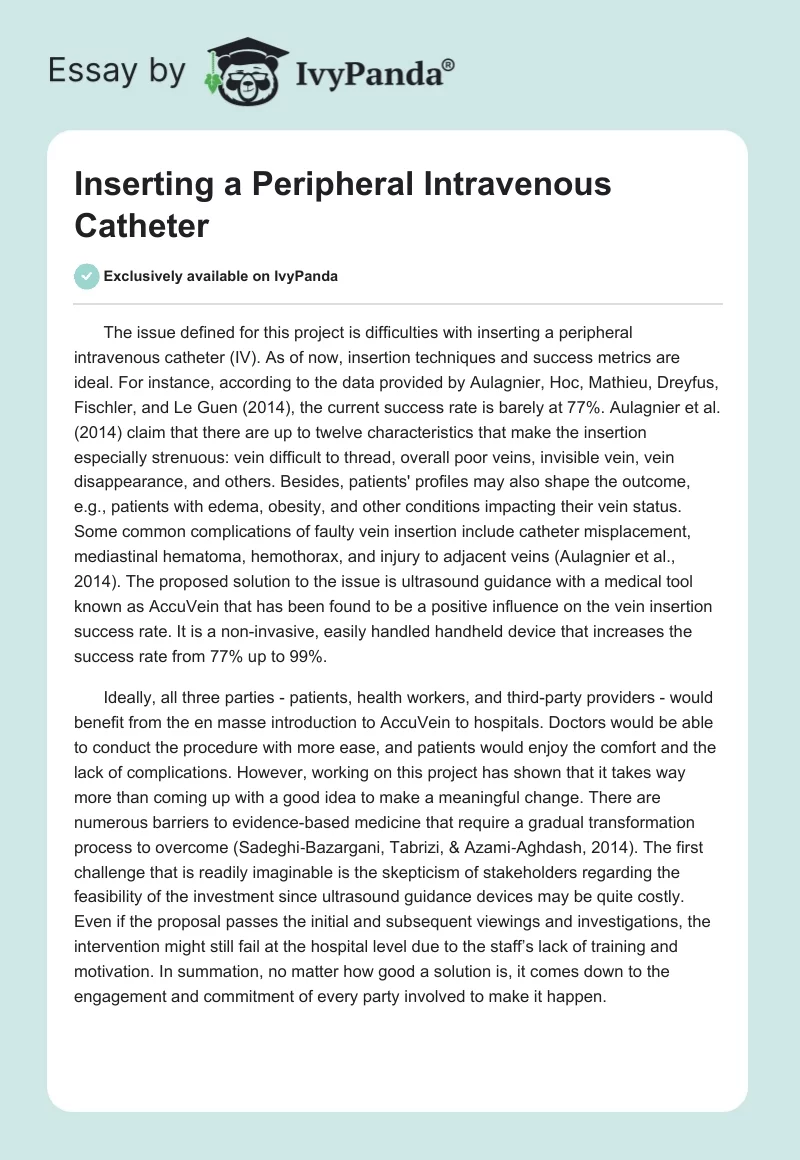The issue defined for this project is difficulties with inserting a peripheral intravenous catheter (IV). As of now, insertion techniques and success metrics are ideal. For instance, according to the data provided by Aulagnier, Hoc, Mathieu, Dreyfus, Fischler, and Le Guen (2014), the current success rate is barely at 77%. Aulagnier et al. (2014) claim that there are up to twelve characteristics that make the insertion especially strenuous: vein difficult to thread, overall poor veins, invisible vein, vein disappearance, and others. Besides, patients’ profiles may also shape the outcome, e.g., patients with edema, obesity, and other conditions impacting their vein status. Some common complications of faulty vein insertion include catheter misplacement, mediastinal hematoma, hemothorax, and injury to adjacent veins (Aulagnier et al., 2014). The proposed solution to the issue is ultrasound guidance with a medical tool known as AccuVein that has been found to be a positive influence on the vein insertion success rate. It is a non-invasive, easily handled handheld device that increases the success rate from 77% up to 99%.
Ideally, all three parties – patients, health workers, and third-party providers – would benefit from the en masse introduction to AccuVein to hospitals. Doctors would be able to conduct the procedure with more ease, and patients would enjoy the comfort and the lack of complications. However, working on this project has shown that it takes way more than coming up with a good idea to make a meaningful change. There are numerous barriers to evidence-based medicine that require a gradual transformation process to overcome (Sadeghi‐Bazargani, Tabrizi, & Azami‐Aghdash, 2014). The first challenge that is readily imaginable is the skepticism of stakeholders regarding the feasibility of the investment since ultrasound guidance devices may be quite costly. Even if the proposal passes the initial and subsequent viewings and investigations, the intervention might still fail at the hospital level due to the staff’s lack of training and motivation. In summation, no matter how good a solution is, it comes down to the engagement and commitment of every party involved to make it happen.
References
Aulagnier, J., Hoc, C., Mathieu, E., Dreyfus, J. F., Fischler, M., & Le Guen, M. (2014). Efficacy of AccuVein to facilitate peripheral intravenous placement in adults presenting to an emergency department: a randomized clinical trial. Academic Emergency Medicine, 21(8), 858-863.
Sadeghi‐Bazargani, H., Tabrizi, J. S., & Azami‐Aghdash, S. (2014). Barriers to evidence‐based medicine: a systematic review. Journal of Evaluation in Clinical Practice, 20(6), 793-802.


